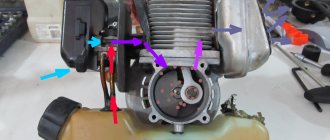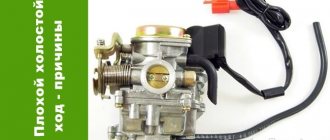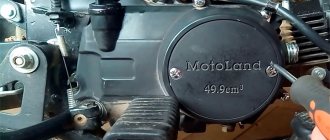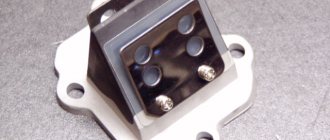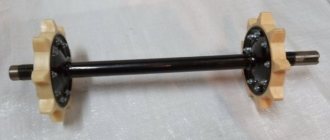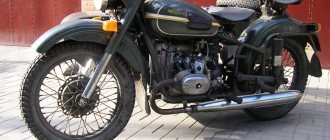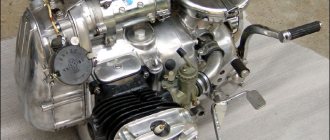What does an internal combustion engine consist of?
You need to start with what an internal combustion engine :
– the cylinder head is a kind of vessel for the combustion chamber of the working mixture, gas distribution valves with a drive, spark plugs and injectors;
– cylinders are hollow parts with a cylindrical inner surface; pistons move in the cylinders;
– pistons are moving parts that tightly cover the cylinders in cross section and move along their axis;
– piston rings are open rings that are tightly seated in grooves on the outer surfaces of the pistons; they seal the combustion chamber, improve heat transfer through the cylinder walls and regulate lubricant flow;
– piston pins serve to articulate the piston with the connecting rod, each of them is an axis relative to which the connecting rod makes an oscillatory movement.;
– connecting rods are a link of a flat mechanism, connected to other moving links through rotational kinematic pairs and performing a complex flat movement;
– a crankshaft is a shaft consisting of several cranks;
– flywheel – a massive rotating wheel used as a storage device (inertial battery) of kinetic energy;
– a camshaft with cams is the main part of the gas distribution mechanism (GRM), which serves to synchronize the intake or exhaust and engine operating strokes;
– valves are mechanisms with which you can, at will, open or close openings for various purposes;
– spark plugs serve to ignite the combustible mixture; they are a set of electrodes between which a spark occurs.
But for the internal combustion engine to fully operate, several more systems are needed:
– the internal combustion engine power system consists of a fuel tank, fuel filters, fuel lines, a fuel pump, an air filter, an exhaust system and a carburetor (if the engine is not fuel-injected);
– the exhaust gas system of the internal combustion engine consists of an exhaust valve, an exhaust channel, a muffler exhaust pipe, an additional muffler (resonator), a main muffler, and connecting clamps;
– the internal combustion engine ignition system consists of a power source for the ignition system (battery and generator), an ignition switch, an energy storage control device, an energy storage device (for example, an ignition coil), an ignition distribution system, high-voltage wires and spark plugs;
– engine cooling system consists of specially designed double walls of the cylinder block and heads (the space between them is filled with coolant), a radiator, an expansion tank, a pump, a thermostat and pipelines;
-the lubrication system consists of a sump, an oil pump, an oil filter, pipes, channels and holes for oil supply.
ICE working mixture
The very name of combustion engine - INTERNAL COMBUSTION - hints that something is burning there. And, of course, it is not the fuel itself that burns, but only its vapor mixed with air. This mixture is usually called working. The combustion of this mixture has a peculiarity - it burns, significantly increasing in volume, creating, so to speak, a shock wave for the cylinder pistons.
The carburetor or injector is responsible for creating the working mixture, respectively, depending on the type of engine.
Where is it used?
Engine diagram 1zr fe
4-stroke engines are used very widely in our daily life. Their power directly depends on the volume and number of cylinders. ICEs are installed in cars and airplanes, tractors and diesel locomotives. They are also used on sea and river vessels.
Power engineers also paid attention to 4-stroke power units. They are used to power stationary and emergency power generators installed in places where power lines cannot be laid or are not economically feasible.
In addition, such generators are installed at facilities where turning off the power supply is impossible (hospitals, banks, military units, etc.).
ICE operating cycles
The above diagram is extremely simplified. Now let's look at everything that happens in the internal combustion engine in more detail. The classic scheme of operation of an internal combustion engine is to divide it into cycles. In order to consider each stroke of the engine, you need to understand several definitions:
Top dead center (TDC) is the highest position of the piston in the cylinder.
Bottom dead center (BDC) is the lowest position of the piston in the cylinder.
Piston stroke is the distance between TDC and BDC.
The combustion chamber is the volume in the cylinder above the piston when it is at TDC.
Cylinder displacement is the volume above the cylinder piston when it is at BDC.
Engine displacement is the total displacement of all cylinders.
The compression ratio of an internal combustion engine is the ratio of the total volume of the cylinder to the volume of the combustion chamber.
Main settings
The total volume of the cylinder (Va) is the volume enclosed between the head, cylinder and piston when it is at BDC;
Compression chamber volume (VC) is the volume enclosed between the head, cylinder and piston when it is at TDC;
Cylinder displacement (Vh) is the volume formed when the piston moves from TDC to BDC (Vh = Va-Vc);
Total engine volume (iVh) is the sum of the working volumes of all engine cylinders; This is the displacement of the engine.
Compression ratio (E) is the ratio of the total volume to the volume of the compression chamber (E = Va/Vc = 1 + Vh/Vc);
The compression ratio shows how many times the combustible mixture is compressed in the cylinder. The higher the compression ratio, the greater the pressure on the piston during combustion of the mixture, and therefore the greater the engine power. Increasing the compression ratio is very beneficial - you can get more useful work from the same portion of fuel. However, if the compression ratio is increased excessively, the working mixture self-ignites, and the mixture burns at high speed—fuel detonation occurs. Detonation is an unacceptably rapid combustion of the working mixture, causing unstable engine operation. When the engine detonates, a sharp knock appears, its power decreases, and black smoke comes out of the muffler. Designers are finding ways to combat fuel detonation and gradually increase the compression ratio. Depending on the compression ratio, a certain type of fuel is used.
Exhaust – 4th cycle of internal combustion engine operation
During the fourth stroke of the internal combustion engine, the exhaust valve opens while the intake valve is closed. The piston, returning to TDC, pushes the exhaust gases out of the cylinder into the exhaust channel, which leads straight through the muffler into the atmosphere.
All four cycles of internal combustion engine operation are repeated cyclically. But the most important of them is certainly the third - ensuring the working movement. The remaining strokes are auxiliary, only for the “organization” of the third stroke, which moves the car.
The four-stroke engine is a piston internal combustion engine. The working process of all cylinders in these units takes 2 crankshaft revolutions or four piston strokes. Since the mid-twentieth century, the 4-stroke engine has been the most common type of piston engine.
Types of motors
There are three types of engines found in vehicles:
- piston
- rotary piston
- gas turbine
The first version of motors is very popular. Some car models are equipped with four-stroke piston engines. This popularity is due to the fact that such units are cheaper, light in weight and suitable for use in almost all machines, regardless of production.
In simple terms, a car engine is a special mechanism that can change heat energy, turning it into mechanical energy, which makes it possible to ensure the operation of many structural elements of the car, as well as its systems.
It is not difficult to study the principle of operation of the motor. For example, piston internal combustion engines are divided into two- and four-stroke units. Four-stroke engines are called because in one operating cycle of the element the piston moves four times (stroke). More information about what bars are is written below.
Operating principle and main characteristics
The operating cycle of an internal combustion engine (ICE) consists of a series of processes that increase the power of the engine acting on the crankshaft. The work cycle consists of several stages:
- the cylinder is filled with the fuel mixture;
- the mixture is compressed;
- the fuel mixture ignites;
- the gases expand and the cylinder is cleaned.
In an internal combustion engine, the piston moves in one direction (up or down). The crankshaft makes one revolution in two strokes. The working stroke of the piston is the one during which useful work is performed and the burnt gases expand.
Two-stroke engines are those in which the cycle is completed in one revolution of the crankshaft or in two strokes. Four-stroke units are characterized by completing a working cycle in two revolutions of the crankshaft or in four strokes .
Main characteristic indicators of a 4-stroke engine:
- Due to the movement of the working piston, gases are exchanged.
- The unit is equipped with a gas distribution mechanism that allows the cylinder cavity to be switched to inlet and outlet.
- An exchange of gases occurs at the moment of a separate half-turn of the crankshaft.
- Gear reducers and a belt chain drive make it possible to change the timing of gasoline injection, ignition and gas distribution mechanism drive in relation to the crankshaft speed.
Application
Four-stroke engines can be either gasoline or diesel. They find the widest application as prime movers in stationary and transport power plants.
As a rule, four-stroke engines are used in cases where it is possible to more or less widely vary the ratio of shaft revolutions to output power and torque, or when this ratio does not play a role in the operation of the machine. For example, an engine loaded by an electric generator can, in principle, have any operating characteristic and is consistent with the load only over the operating speed range, which, in principle, can be any acceptable for the generator. The use of intermediate gears generally makes a four-stroke engine more adaptable to loads over a wide range. They are also more preferable in cases where the installation operates for a long time outside the steady state - thanks to more advanced gas dynamics, their operation in transient modes and modes with partial power removal is more stable.
When operating on a shaft in a given speed range, especially low-speed ones (the propeller shaft of a motor ship), it is preferable to use two-stroke engines, as they have more favorable mass-power characteristics at low speeds.
Story
Around 1854-1857, the Italians Felicce Matoczi and Eugene Barsanti created a device that, according to the information available today, was similar to a four-stroke engine . The invention of the Italians was lost only in 1861. Alphon de Rocher patented an engine of this type.
The first workable four-stroke engine was created by the German engineer Nikolaus Otto . The four-stroke cycle of operation was named in his honor as the Otto cycle, and a 4-stroke engine using spark plugs is called an Otto engine.
Features of a 4-stroke engine
In a two-stroke engine, lubrication of the piston and cylinder pins, crankshaft, piston, bearing and compressor rings is carried out by pouring oil into gasoline. The crankshaft of a 4-stroke engine is located in an oil bath, which is a significant difference. That is why there is no need to mix fuel and add oil. All the car owner needs to do is fill the fuel tank with gasoline.
The car owner, therefore, has no need to purchase special oil, without which a two-stroke engine cannot function. In addition, with a four-stroke engine, the amount of carbon deposits on the piston mirror and on the walls of the muffler is reduced. Another important difference is that in a two-stroke engine, a flammable mixture splashes into the exhaust pipe, which is due to its design.
It should be recognized that four-stroke engines also have minor disadvantages. For example, their working moments for regulating the thermal valve clearance are not particularly high-quality.
Unit design
The camshaft of a four-stroke engine is located in the cylinder cover. It is driven by a drive wheel mounted in the crankshaft. The camshaft opens and closes one of the valves: exhaust or intake, depending on the location of the piston. The camshaft also contains cams that operate the valve rocker arms.
Once triggered, the rocker arms It is important that there must be a thermal gap (narrow gap) between the adjusting screw and the valve. When heated, the metal expands, so if the gap is too small or there is none at all, the valves cannot completely close the exhaust and intake passages.
at the intake valve should be smaller than at the exhaust valve, because the exhaust gases are hotter than the mixture. Accordingly, the intake valve heats up less than the exhaust valves.
Rating of outboard motors by manufacturer
Often the choice of users is based on the brand and country of origin, so let’s consider this factor first. So, what are the best outboard motors: German, Japanese, American, Korean, Chinese or domestic? Let's look at the ranking of outboard motor manufacturers.
Even beginner boat motorists have heard that the most reliable and best boat motor is a device made in Japan or America. Engines from famous brands are especially highly valued, including:
- Tohatsu;
- Mercury;
- Yamaha;
- Evinrude;
- Honda;
- Johnson;
- Suzuki.
Each of the listed companies has many years of experience in the production of motor vehicles. Therefore, it is impossible to definitely decide which company has the best outboard motor, because each company has its own developments and technologies, and the models have their own distinctive features. But one thing is for sure: Japanese and American products when imported to Russia turn out to be expensive. Therefore, those who cannot afford such expenses prefer to buy engines made in China.
You might be interested: How to store a boat motor in winter - preservation, choosing a room
By the way, Chinese devices may not be the best outboard motors, but they are also quite decent. Especially when we are talking about companies from the top 10 motor manufacturers in China. For example, these include companies:
- Parsun;
- HDX;
- SEA PRO;
- Hangkai;
- Hidea;
- Marlin et al.
The products of these manufacturers have won the trust of users not only with their low price, but also with their good performance.
Also among the alternatives to American and Japanese engines, we note the South Korean one. Motors of this brand have proven to be relatively inexpensive, but reliable in use.
Having decided on a group of leading manufacturers, we will continue our review of outboard motors specifically based on their parameters. Let's start with the basic principle of operation, i.e. number of cycles.
Engine operation
As already noted, the operation of a four-stroke engine consists of four strokes of the piston or two revolutions of the crankshaft.
- Inlet . The piston moves downward, opening the intake valve. From the carburetor the combustible mixture enters the cylinder. When the piston reaches the bottom position, the intake valve closes.
- Compression . The piston moves upward, causing the combustible mixture to compress. When it approaches the top point, the compressed gasoline ignites.
- Extension . Gasoline ignites and burns. As a result, the flammable gases are stretched and the piston moves downwards. In this case, two valves are closed.
- Release . The crankshaft continues to move around its axis by inertia, and the piston moves upward. At the same time, the exhaust valve opens and exhaust gases enter the pipe. When the valve passes the dead center, the intake valve closes.
Read also: How to choose a thermal head for a heating radiator
Application
Four-stroke engines can be either gasoline or diesel. They find the widest application as prime movers in stationary and transport power plants.
As a rule, four-stroke engines are used in cases where it is possible to more or less widely vary the ratio of shaft revolutions to output power and torque, or when this ratio does not play a role in the operation of the machine. For example, an engine loaded by an electric generator can, in principle, have any operating characteristic and is consistent with the load only over the operating speed range, which, in principle, can be any acceptable for the generator. The use of intermediate gears generally makes a four-stroke engine more adaptable to loads over a wide range. They are also more preferable in cases where the installation operates for a long time outside the steady state - thanks to more advanced gas dynamics, their operation in transient modes and modes with partial power removal is more stable.
When operating on a shaft in a given speed range, especially low-speed ones (the propeller shaft of a motor ship), it is preferable to use two-stroke engines, as they have more favorable mass-power characteristics at low speeds.
Design and operational differences of four-stroke two-stroke gasoline engines
The main difference between a four-stroke engine and a two-stroke engine is due to different gas exchange mechanisms , namely: the removal of exhaust gases and the supply of a fuel-air mixture to the cylinder.
The processes of filling the cylinder and cleaning it in a four-stroke engine occur with the help of a special gas distribution mechanism, which at a certain time opens and closes the working cycle.
Cylinder cleaning and filling in a two-stroke engine is carried out at the same time as expansion and compression when the piston is near the dead bottom point. For this purpose, there are two holes in the cylinder walls: purge or inlet and outlet . The fuel mixture enters through the outlet and exhaust gases exit.
The main differences between two-stroke and four-stroke engines:
- Liter capacity. In a four-stroke engine, there is one power stroke per two revolutions of the crankshaft. Therefore, theoretically, a two-stroke engine should have twice the liter power of a four-stroke engine. But in practice, the excess is about 1.8 times, due to the use of a piston when expanding the stroke, as well as the presence of a worse mechanism for releasing exhaust gases from the cylinder and high costs for purging part of the power.
- Fuel consumption. The two-stroke engine is superior to the four-stroke in specific and liter power, but inferior in efficiency. Exhaust gases are displaced by the air-fuel mixture, which enters the cylinder from the connecting rod-crank chamber. Part of the fuel mixture enters the exhaust channels and is removed with the exhaust gases.
- For two-stroke and four-stroke engines, the principle of engine lubrication is significantly different. Two-stroke models are characterized by the need to mix gasoline with engine oil in certain proportions. The oil-air-fuel mixture circulates in the piston and crank chambers, lubricating the crankshaft and connecting rod bearings. When the fuel mixture ignites, tiny drops of oil burn together with gasoline. Combustion products leave along with exhaust gases.
Gasoline and oil are mixed in two ways. This can be as simple as stirring before adding fuel to the tank and separating the transmission. In the second case, the oil-fuel mixture is formed in the inlet pipe located between the cylinder and the carburetor.
The engine in the latter case is equipped with an oil tank with a pipeline connected to a plunger pump. The pump supplies oil to the inlet pipe in the amount required. The performance of the pump depends on how the gas handle is positioned. The more fuel supplied, the greater the oil supply. The separate lubrication system of a two-stroke engine is more advanced. The ratio of gasoline to oil can reach 200:1. This leads to reduced oil consumption and reduced smoke. This system is used, for example, on modern scooters.
In four-stroke engines, gasoline is not mixed with oil, but is supplied separately, for which the engines have a classic lubrication system, which consists of a filter, an oil pump, a pipeline and valves. The oil tank can be the engine crankcase (wet sump lubrication) or a separate tank (dry sump).
In the first case, the pump sucks oil from the sump, directs it into the inlet cavity, and then through the channels to the parts of the connecting rod and crank group, to the crankshaft bearings and gas distribution mechanism.
In the case of dry sump lubrication, the oil is poured into the barrel. From there it gets to the rubbing surfaces using a pump. The part of the oil that flows into the crankcase is pumped out by an additional pump and returned to the tank.
To clean the oil from various wear products, the engine has a filter. In addition, if necessary, install cooling filters, because the oil temperature during operation can rise very much.
The processes occurring in the engine cylinders during operation are repeated cyclically. One such operating cycle is considered to be a set of strokes (intake of the air-fuel mixture, compression, ignition and expansion of gases, as well as the release of combustion products), ensuring the transfer of thermal energy released during the ignition of one portion of the mixture directly into work. What the operating cycles of piston internal combustion engines are will be discussed below.
Assistance systems
Since a 4-stroke engine is more complex than a 2-stroke engine, for normal operation it needs auxiliary systems:
- Gas distribution - regulates the supply of the fuel mixture and the removal of exhaust gases using intake and exhaust valves.
- Lubrication - supplies oil to the engine, which reduces the friction force of mechanical parts, cools the mechanism and removes combustion products.
- Fuel supply is a system for supplying fuel from the gas tank to the cylinders. On older gasoline models, the creation of the fuel mixture occurs in the carburetor, and on injection engines, fuel is injected directly through the injectors.
- Ignition (on gasoline units) - the system alternately supplies current from the distributor to each spark plug, and from there to the combustion chambers. On some car models (for example, VAZ 2106), to increase the voltage supplied to the spark plugs, a capacitor is installed on the distributor.
- Cooling is an additional water circuit that removes excess heat from the engine.
- Exhaust system - cleans exhaust gases and releases them into the atmosphere.
Four-stroke internal combustion engine M57 from BMW.
The quality of operation and service life of the engine depend on the correct pressure inside the lubrication system , so it is recommended not only to rely on the oil pressure indicator in the cabin, but also to periodically carry out manual measurements using a pressure gauge.
What are dead spots and engine cycles?
The number of stages included in one working cycle of an internal combustion engine (ICE) is usually calculated based on the number of piston strokes in the cylinder. These stages are called engine strokes. The stroke of the piston is directly determined by its movement from one extreme point to another. They are called dead, because if the piston stops at such a point, it will not be able to start moving without external influence. In simple words, dead points are positions at which the movement in the current direction of the piston stops and it begins to reverse.
Dead spots and piston stroke of internal combustion engines
There are two dead spots:
- Lower (BDC) - the position at which the distance between the piston and the axis of rotation of the crankshaft is minimal.
- Top (TDC) - the position at which the cylinder is at the maximum distance from the axis of rotation of the engine crankshaft.
In English-language documentation, TDC is designated as TDC (Top Dead Center), and BDC is designated BDC (Bottom Dead Center).
There are engines whose operating cycle can consist of two or four strokes. Based on this, they are divided into two-stroke and four-stroke engines.
The third stroke is the working stroke.
At the end of the compression stroke (20-30 degrees of rotation angle of the crankshaft before the piston reaches TDC), a portion of fuel is injected in a finely atomized form through a nozzle into the cylinder under high pressure (15-20 MPa) using a pump. Fuel evaporates when it comes into contact with heated air, its vapors mix with the heated air and ignite. When fuel burns, due to the supply of a large amount of heat, the depletion and temperature of the resulting gases sharply increase. At the beginning of the expansion stroke, the gas pressure is 7-8 MPa. and the temperature is 2100-2300 K. Under the influence of pressure, the piston moves from TDC to BDC, performing useful work. The volume of the cylinder increases, the pressure and temperature of the gases decrease and when the piston approaches BDC they are 0.2-0.4 MPa.
How does a four stroke engine work?
Structurally, the working cycle of a typical four-stroke unit is ensured by the operation of the following elements:
Read also: Attachment for hammer drill for driving pins
- cylinder;
- piston - performs reciprocating movements inside the cylinder;
- intake valve - controls the process of supplying the air-fuel mixture to the combustion chamber;
- exhaust valve - controls the process of exhaust gases ejecting from the cylinder;
- spark plug - ignites the resulting air-fuel mixture;
- crankshaft;
- camshaft - controls the opening and closing of valves;
- belt or chain drive;
- crank mechanism - translates the movement of the piston into rotation of the crankshaft.
Duty cycle of a four-stroke engine
The working cycle of such a mechanism consists of four cycles, during which the following processes are implemented:
- Intake (fuel and air injection). At the beginning of the cycle, the piston is at TDC. At the moment when the crankshaft begins to rotate, it acts on the piston and moves it to BDC. This leads to the formation of vacuum in the cylinder chamber. The camshaft acts on the intake valve, gradually opening it. When the piston is in its extreme position, the valve is completely open, resulting in intense injection of fuel and air into the cylinder chamber.
- Compression (increasing the pressure of the combustible mixture). In the second stage, the piston begins to move back to the top dead center of the compression stroke. The crankshaft makes another turn and both valves are completely closed. The internal pressure increases to 1.8 MPa and the temperature of the combustible mixture rises to 600 C°.
- Expansion (working stroke). When the piston reaches the top position in the combustion chamber, the maximum compression is set to 5 MPa and the spark plug is fired. This leads to combustion of the mixture and an increase in temperature to 2500 C°. Pressure and temperature lead to an intense impact on the piston, and it begins to move back to BDC. The crankshaft makes another turn, and thus the thermal energy is converted into useful work. The camshaft opens the exhaust valve, and when the piston reaches BDC, it is fully open. As a result, the exhaust gases begin to gradually leave the chamber, and the pressure and temperature decrease.
- Exhaust (removal of exhaust gases). The engine crankshaft turns and the piston begins to move to the top point. This leads to the expulsion of exhaust gases and an even greater decrease in temperature and a decrease in pressure to 0.1 MPa. Next, a new cycle begins, during which these processes are repeated again.
During each stroke, the engine crankshaft rotates 180°. During a full working cycle, the crankshaft rotates 720°.
The four-stroke engine has become widespread. It can work with both gasoline and diesel fuel. The difference between the operating cycle for a diesel engine is that the ignition of the air-fuel mixture does not occur from a spark, but from high pressure and temperature at the end point of the compression stroke.
Motor device
Before understanding the principle of operation, you should first understand how the power unit is structured and what is included in its design. Since piston ones are considered the most in demand, just such a device will be considered. The main details include:
- Cylinders forming a separate block
- Timing block head
- crank mechanism
The latter drives the crankshaft, causing it to rotate. The mechanism transmits to the shaft the energy received from the moving piston, which changes its position in several strokes. The movement of the piston is controlled by the heat energy resulting from the combustion of fuel.
It is impossible to imagine and organize the movement of a power unit without the mechanisms installed in it. For example, the timing belt changes the position of the valves, due to which it is possible to ensure a regular supply of fuel by admitting and releasing certain compounds. The system for the entry of new gases and the exit of exhaust gases has been established.
